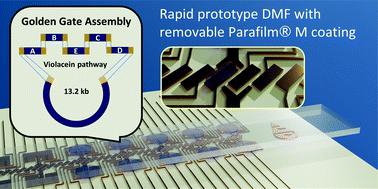Our official English website, www.x-mol.net, welcomes your feedback! (Note: you will need to create a separate account there.)
Expanding the limits towards ‘one-pot’ DNA assembly and transformation on a rapid-prototype microfluidic device
Lab on a Chip ( IF 6.1 ) Pub Date : 2021-08-09 , DOI: 10.1039/d1lc00415h James M Perry 1, 2 , Guy Soffer 2, 3 , Raja Jain 1, 2 , Steve C C Shih 1, 2, 3
Lab on a Chip ( IF 6.1 ) Pub Date : 2021-08-09 , DOI: 10.1039/d1lc00415h James M Perry 1, 2 , Guy Soffer 2, 3 , Raja Jain 1, 2 , Steve C C Shih 1, 2, 3
Affiliation

|
DNA assembly and transformation are crucial to the building process in synthetic biology. These steps are significant roadblocks when engineering increasingly complex biological systems. To address this, recent development of widespread ‘biofoundry’ facilities has employed automation equipment to expedite the synthetic biology workflow. Despite significant progress, there is a clear demand for lower-cost and smaller-footprint automation equipment. The field of microfluidics have emerged to provide automation capabilities to meet this demand. However, we still lack devices capable of building large multi-gene systems in a consolidated process. In response to this challenge, we have developed a digital microfluidic platform that performs “one-pot” Golden Gate DNA assembly of large plasmids and transformation of E coli. The system features a novel electrode geometry and modular design, which make these devices simple to fabricate and use, thus improving the accessibility of microfluidics. This device incorporates an impedance-based adaptive closed loop water replenishment system to compensate for droplet evaporation and maintain constant assembly reaction concentrations, which we found to be crucial to the DNA assembly efficiency. We also showcase a closed-loop temperature control system that generates precise thermodynamic profiles to optimize heat shock transformation. Moreover, we validated the system by assembling and transforming large and complex plasmids conferring a biosynthetic pathway, resulting in performance comparable to those of standard techniques. We propose that the methods described here will contribute to a new generation of accessible automation platforms aimed at speeding up the ‘building’ process, lowering reagent consumption and removing manual work from synthetic biology.
中文翻译:

在快速原型微流体装置上扩大对“一锅”DNA 组装和转化的限制
DNA 组装和转化对于合成生物学的构建过程至关重要。在设计越来越复杂的生物系统时,这些步骤是重要的障碍。为了解决这个问题,最近开发的广泛的“生物铸造”设施采用了自动化设备来加快合成生物学工作流程。尽管取得了重大进展,但对成本更低、占地面积更小的自动化设备的需求仍然明显。微流体领域的出现提供了自动化能力来满足这一需求。然而,我们仍然缺乏能够在整合过程中构建大型多基因系统的设备。为应对这一挑战,我们开发了一个数字微流体平台,可以执行大质粒的“一锅”金门 DNA 组装和大肠杆菌的转化. 该系统具有新颖的电极几何形状和模块化设计,使这些设备易于制造和使用,从而提高了微流体的可及性。该装置结合了基于阻抗的自适应闭环补水系统,以补偿液滴蒸发并保持恒定的组装反应浓度,我们发现这对 DNA 组装效率至关重要。我们还展示了一个闭环温度控制系统,该系统可生成精确的热力学曲线以优化热激转换。此外,我们通过组装和转化赋予生物合成途径的大型复杂质粒来验证该系统,从而获得与标准技术相当的性能。
更新日期:2021-08-09
中文翻译:

在快速原型微流体装置上扩大对“一锅”DNA 组装和转化的限制
DNA 组装和转化对于合成生物学的构建过程至关重要。在设计越来越复杂的生物系统时,这些步骤是重要的障碍。为了解决这个问题,最近开发的广泛的“生物铸造”设施采用了自动化设备来加快合成生物学工作流程。尽管取得了重大进展,但对成本更低、占地面积更小的自动化设备的需求仍然明显。微流体领域的出现提供了自动化能力来满足这一需求。然而,我们仍然缺乏能够在整合过程中构建大型多基因系统的设备。为应对这一挑战,我们开发了一个数字微流体平台,可以执行大质粒的“一锅”金门 DNA 组装和大肠杆菌的转化. 该系统具有新颖的电极几何形状和模块化设计,使这些设备易于制造和使用,从而提高了微流体的可及性。该装置结合了基于阻抗的自适应闭环补水系统,以补偿液滴蒸发并保持恒定的组装反应浓度,我们发现这对 DNA 组装效率至关重要。我们还展示了一个闭环温度控制系统,该系统可生成精确的热力学曲线以优化热激转换。此外,我们通过组装和转化赋予生物合成途径的大型复杂质粒来验证该系统,从而获得与标准技术相当的性能。


























 京公网安备 11010802027423号
京公网安备 11010802027423号